
10 Tips for Building a Successful Website for Your Business
Table of Contents
A strong online presence is critical for the success of any business in today’s digital age, and a website is often the first point of contact between a company and its customers. A well-designed and optimized website can be the key to reaching new customers, driving sales, and building a strong brand for small businesses in Botswana.
Creating a successful website, on the other hand, can be a challenging task, especially for those with limited technical or design experience. Mme o seka wa tshwenyega, in this blog post, we’ll share 10 website design tips to help your business stand out and succeed online.
Tip #1: Define Your Target Audience
Defining your target audience is one of the most important steps in creating a successful website for your company. Knowing who your ideal customer is will help you design, function, and content your website.
Consider age, gender, location, income, and interests when defining your target audience. This data will not only assist you in developing a website that appeals to your target audience, but it will also inform your overall digital marketing strategy. If your target audience consists primarily of young professionals, you may want to prioritize social media marketing and mobile optimization, wa itse le wena gore young people spend the majority of their time on their phones and social media.
Once you understand your target audience, you can tailor your website to their needs and preferences. This will improve your chances of converting visitors into customers and, ultimately, helping your business grow.
It is also important to note that as your business grows, your target audience may change, so it is critical to continuously monitor and adjust your website and digital marketing strategy to meet the needs of your current target audience.
You can use Google Analytics and Facebook Audience Insights to gain insights into your website visitors and Facebook users demographics, behavior, and interests to define your target audience.
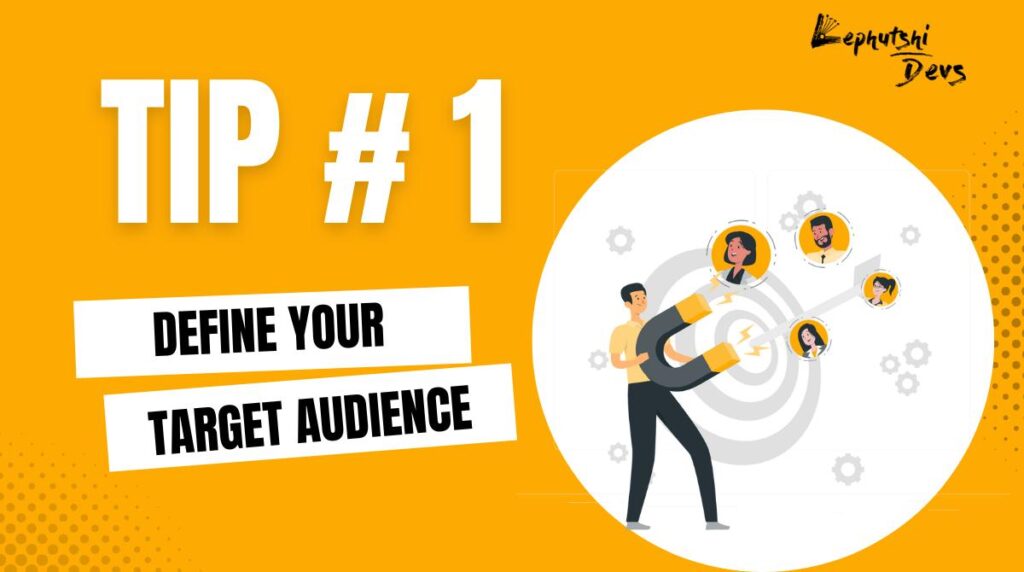
Tip #2: Make it Mobile-Friendly
With more people accessing the internet via smartphones and other mobile devices, it’s critical that your website is mobile-friendly. A mobile-friendly website not only improves the user experience for visitors using smartphones to access your site, but it also increases your visibility in search engine results.
There are several approaches you can take to make your website mobile-friendly, including:
- Using a responsive design: This means that your website’s layout will automatically adjust to fit the screen of the device used to access it. This ensures that all content is readable and navigation is simple, regardless of whether the user is on a desktop, tablet, or smartphone.
- Using a mobile-specific design: This entails creating a mobile-specific version of your website. This method is more time-consuming and expensive, but it may be required if your website includes features or functionality that do not work well on mobile devices.
- Using AMP (Accelerated Mobile Pages): This is an open-source project that aims to reduce the time it takes for web pages to load on mobile devices. Pages created with AMP use simplified HTML and limited JavaScript, allowing them to load faster on mobile devices. You can learn more about AMP by visiting their website: https://www.ampproject.org/
Whatever approach you take, it’s critical to test your website on a variety of mobile devices to ensure that it’s fully optimized for mobile.
In addition to the technical aspects of mobile optimization, the user experience on a mobile device, such as the size of the buttons, font size, and amount of scrolling required to view the content, must be considered.
Making your website mobile-friendly will not only improve the user experience for your visitors, but it will also increase your chances of ranking well in search engine results, resulting in more traffic and leads to your website.
Check your website’s mobile-friendliness with Google’s mobile-friendly test and improve user experience and search engine visibility now.
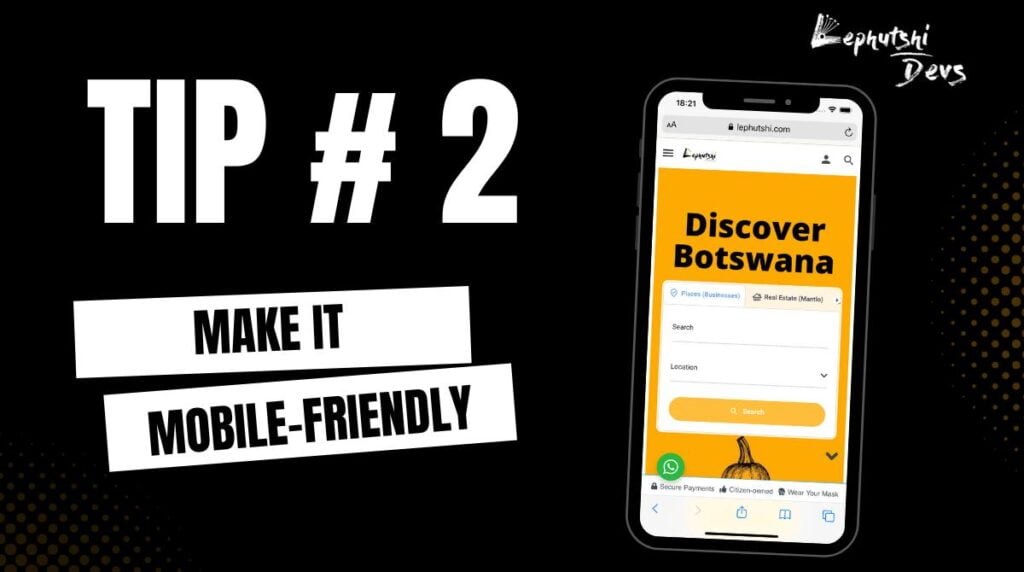
Tip #3: Keep it Simple and Clean
A simple and clean website design can improve user experience and conversions. A cluttered and busy design can be overwhelming, making it difficult for visitors to find the information they seek. A simple design, on the other hand, allows visitors to easily navigate and find the information they require, which can lead to more conversions and, ultimately, more sales for your company. Ke gore go nne motlhofo for your customers go tobetsa and navigate your website.
When designing your website, keep in mind the following tips:
- Use a limited color palette: To achieve a cohesive and polished look, stick to a limited color palette. This will also make it easier for visitors to navigate and find the information they require.
- Use white space effectively: Make use of white space to create balance and to make your website’s content easier to read and understand.
- Use high-quality images: Use high-quality images that are relevant to your company and will assist visitors in understanding your message.
- Keep the navigation simple: Use a simple navigation menu that makes it easy for visitors to find the information they need.
- Use a consistent layout: Use a consistent layout throughout your website to create a sense of unity and to make it easy for visitors to navigate.
Maintaining a simple and clean website design will create a positive user experience and make it easier for visitors to convert into customers. This will eventually help your company grow.
It’s also important to note that, while maintaining a simple design, you should make your website visually engaging, with elements like typography, images, and videos that draw attention and make it more interesting to visitors.

Tip #4: Use High-Quality Images and Videos
Images and videos can improve the user experience and increase the engagement of your website. High-quality images and videos can also help to tell your company’s story and communicate your message in ways that text cannot. However, it is critical to use images and videos that are relevant to your company and will assist visitors in understanding your message. Makgowa bare a “A picture is worth a thousand words” now imagine a video.
Keep the following tips in mind when using images and videos:
Use high-resolution images: High-resolution images will ensure that your images look crisp and clear on any device.
Use images that are relevant to your business: Use images that are relevant to your business and that will help visitors understand your message.
Use videos to tell your story: Use videos to tell your business’s story and convey your message in a way that text alone can’t.
Use video thumbnails: Use video thumbnails to help visitors understand what the video is about.
Optimize images and videos for web: Optimize images and videos for web to ensure that they load quickly, which will improve user experience.
By using high-quality images and videos, you can create a more engaging user experience and make it easier for visitors to understand your message. This will eventually help your business grow.
It’s also worth noting that when including images and videos, keep file size in mind and optimize them for web to ensure that the pages load quickly and don’t slow down the website.
Find high-quality stock (copyright free) images and videos on Pexels, and host and optimize your videos on YouTube or Vimeo for a more engaging website experience.
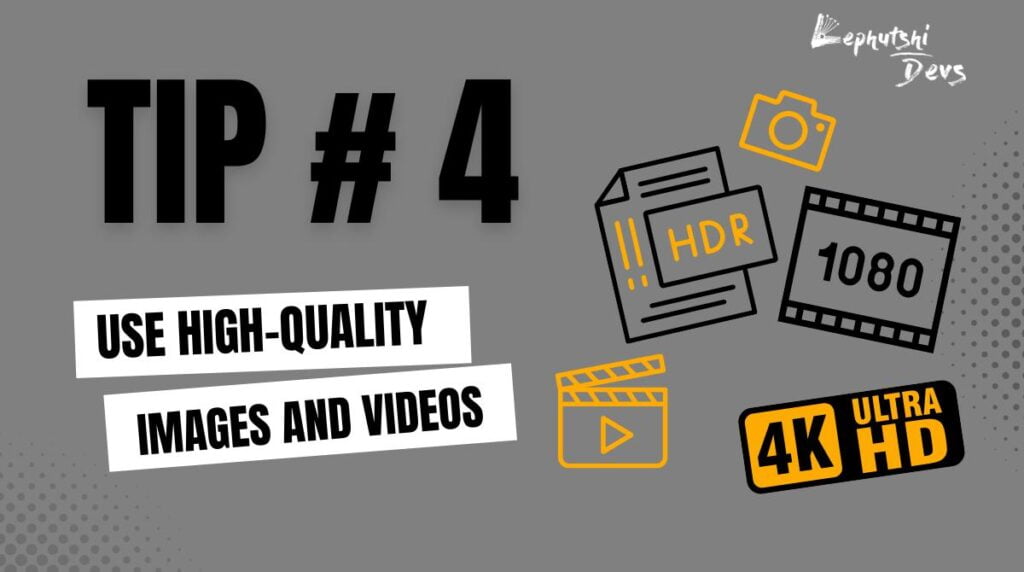
Tip #5: Optimize for Search Engines
Optimizing your website for search engines like Google is critical for increasing visibility and driving traffic to your website. When optimizing your website for search engines, it is critical to consider both on-page and off-page elements.
On-page optimization includes elements such as your website’s content, meta tags, and internal linking structure. Backlinks and social media signals are examples of off-page optimization.
Here are some pointers on how to optimize your website for search engines:
Use keywords in your content: Use keywords in your content that are relevant to your business and that will help search engines understand the topic of your website.
Use meta tags: Use meta tags, such as the title tag and meta description, to provide information about your website to search engines.
Use internal linking: Use internal linking to help search engines understand the structure of your website and to make it easier for visitors to navigate.
Build backlinks: Build backlinks to your website from other reputable websites, which can help to increase your visibility in search engine results.
Use social media: Use social media to promote your website and to build social signals, which can help to increase your visibility in search engine results.
You can increase visibility and drive more traffic to your website by optimizing it for search engines. This will eventually help your company grow.
It’s critical to remember that SEO is a continuous process that necessitates consistent effort to keep your website updated and adapt to changes in search engine algorithms.
Using tools like Google Keyword Planner, Ahrefs, SEMrush, and Moz, you can find the best keywords for your website and optimize your content.

Tip #6: Make it Easy to Navigate
A clear and easy-to-use navigation menu is one of the most important aspects of a successful website. A well-designed navigation menu can enhance the user experience and helps visitors in finding what they’re looking for.
Focus on creating an intuitive and easy-to-use navigation menu when designing your website. This can be accomplished by grouping similar pages together, using clear and descriptive labels for each menu item, and ensuring that the menu appears prominently on every page of your website.
Consider including a search bar or a sitemap to make it even easier for visitors to find the information they need.
A well-designed navigation menu is critical for a website’s success. It makes it simple for visitors to find what they’re looking for, which improves their overall experience on your site and increases their likelihood of returning in the future. As a result, pay more attention to creating a user-friendly navigation menu.
You can learn more on how to improve website navigation in this awesome blog; How to Improve Website Navigation

Tip #7: Use Calls-to-Action
CTAs (calls to action) are an essential component of any successful website. They are a method of directing visitors to take a specific action, such as making a purchase, signing up for a newsletter, or scheduling a service.
When designing your website, it is important to consider the different types of CTAs that would be most effective for your business. Some examples of CTAs include:
- “Sign up for our newsletter”
- “Download our free guide”
- “Book a consultation”
- “Shop now“
It’s critical to make your CTAs clear and compelling when creating them. Use action-oriented language, and make it visually appealing by using contrasting colors or a prominent placement on the page.
It’s also a good idea to test different CTA versions to see which ones perform the best. A/B testing can be used to determine which CTA copy and design elements generate the most conversions.
Make sure that you are using CTA in different pages of your website, as well as in your blog articles, and also in your email campaigns.
Calls-to-action are an effective tool for directing visitors to a specific action on your website. You can increase conversions and drive more business for your company by using clear and compelling CTAs.

Tip #8: Incorporate Social Media
Social media is an essential component of any business’s online presence in today’s digital age. Integrating social media into your website can boost engagement, traffic, and ultimately help your business grow.
When incorporating social media into your website, there are a few key things to consider:
- Make sure that your social media icons are prominently displayed on your website, and link them to your various social media profiles.
- Add social sharing buttons to your website, so that visitors can easily share your content on their own social media profiles.
- Use social media to promote your website, and encourage your followers to visit your site.
- Incorporate social proof, such as customer reviews and testimonials, on your website to show the engagement of your customers with your business.
- Use social media widgets, such as a Twitter feed or Instagram feed, to add dynamic content to your website and showcase your social media presence.
By incorporating social media into your website, you can increase the visibility of your brand, build relationships with your customers, and drive more traffic to your website. It also allows you to reach a larger audience and engage with them on a more personal level.
incorporating social media into your website is critical for any business looking to increase engagement and traffic. By making it simple for visitors to connect with your brand on social media, you can strengthen relationships with your customers and, as a result, grow your business.
With that said, please use the icons below to share this fantastic article with your friends so they can begin improving their websites.

Tip #9: Include Testimonials and Reviews
Including customer testimonials and reviews on your website can be an effective way to boost credibility and trust with prospective customers. Positive feedback from satisfied customers can aid in the development of trust and the establishment of your company as a reputable and reliable source.
There are a few best practices to remember when incorporating testimonials and reviews into your website:
- Use real customer testimonials, rather than fake or made-up reviews.
- Include a mix of testimonials and reviews, with a focus on the most recent and relevant feedback.
- Use images and video to showcase customer feedback, as these types of reviews are more engaging and credible.
- Showcase testimonials and reviews prominently on your website, such as on your homepage or on product pages.
Testimonials and reviews can also be included on other pages of your website, such as landing pages, blog posts, and the “About Us” page.
Including customer testimonials and reviews on your website can significantly boost credibility and trust with prospective customers. By displaying positive feedback from satisfied customers, you can establish your company as a credible and trustworthy source, which can lead to increased conversions and sales.
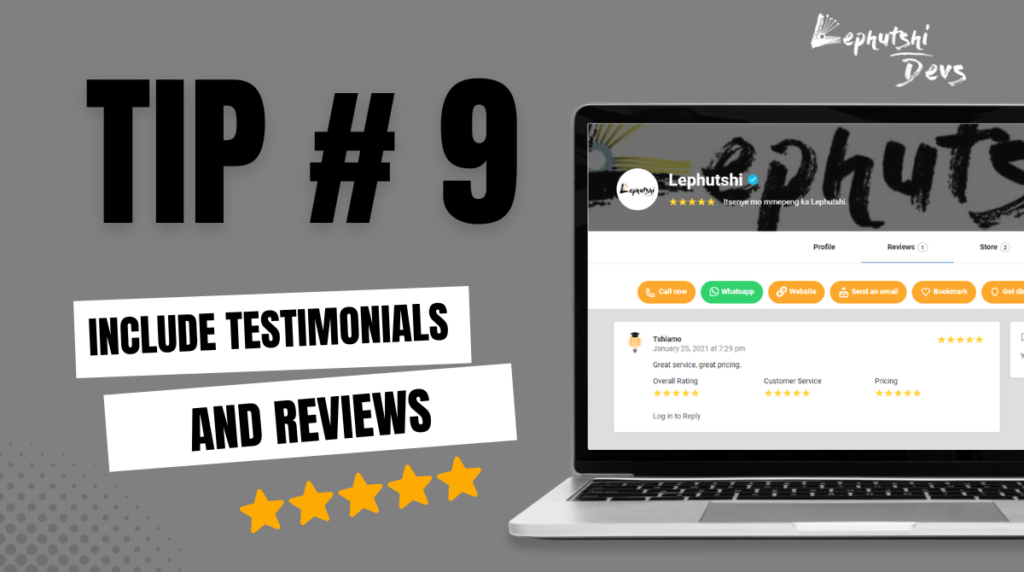
Tip #10: Use A/B Testing
A/B testing, also known as split testing, is a method of comparing two versions of a web page to determine which one performs better. It is a powerful tool that can help you optimize your website and increase conversions and engagement.
A/B testing involves creating two versions of a web page, known as the “A” version and the “B” version. These versions may be identical in most ways, but one or more elements may have been changed. You can, for example, change the color of a call-to-action button, the wording of a headline, or the positioning of a form.
Once the two versions are created, a portion of your website visitors will be directed to the “A” version, while the rest will be directed to the “B” version. By comparing the performance of these two versions, you can determine which one is more effective.
A/B testing can be used for a variety of web page elements, including headlines, images, call-to-action buttons, and form fields. You can identify the most effective version and optimize your website to increase conversions and engagement by testing different variations of these elements.
It is important to note that A/B testing should be done on a consistent basis, as user behavior and preferences may change over time.
A/B testing is a powerful tool for improving your website’s performance. You can identify the most effective version and optimize your website to increase conversions and engagement by comparing two versions of a web page and testing different elements. You can ensure that your website is always at its best and providing the best user experience by using A/B testing on a regular basis.
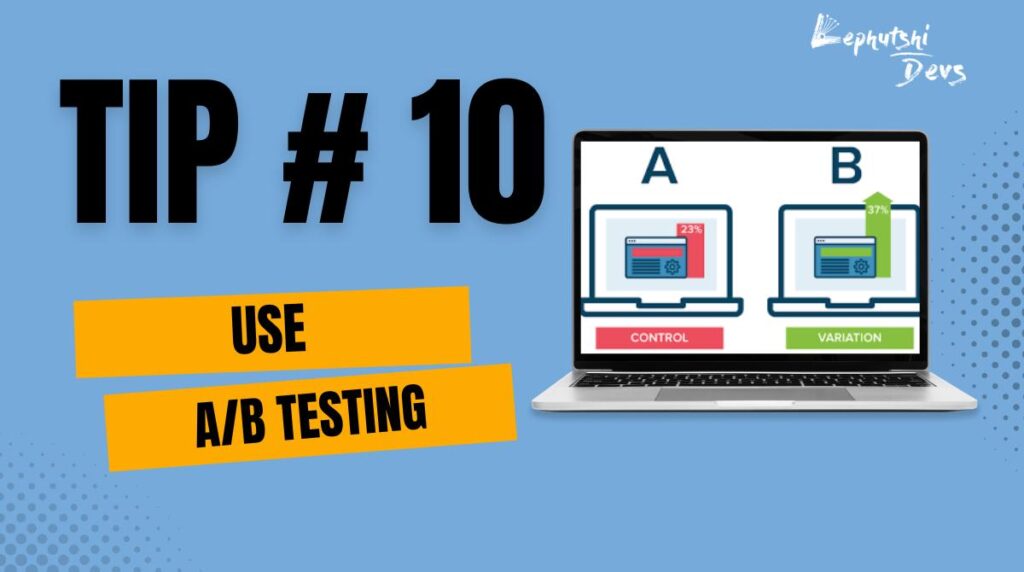
Conclusion
Developing a successful business website is critical for attracting and retaining customers, increasing brand awareness, and improving overall website performance.
To accomplish this, key strategies such as defining your target audience, making the website mobile-friendly, keeping it simple and clean, using high-quality images and videos, optimizing for search engines, making it easy to navigate, incorporating calls-to-action, incorporating social media, including testimonials and reviews, and utilizing A/B testing must be implemented.
Create a website that is both visually appealing and functional for your company. Our team can create a website that will assist you in gaining more customers and increasing your sales. Request our website development services today and see how it can benefit your company.
About Lephutshi Developers
Lephutshi Developers is a Botswana-based digital marketing and web development agency dedicated to helping businesses attract more customers, enhance online visibility, and boost sales. Our team specializes in strategic SEO, engaging web design, and targeted PPC campaigns—delivering tangible results for your brand. Let us handle your digital challenges so you can focus on what matters most: growing your business.

